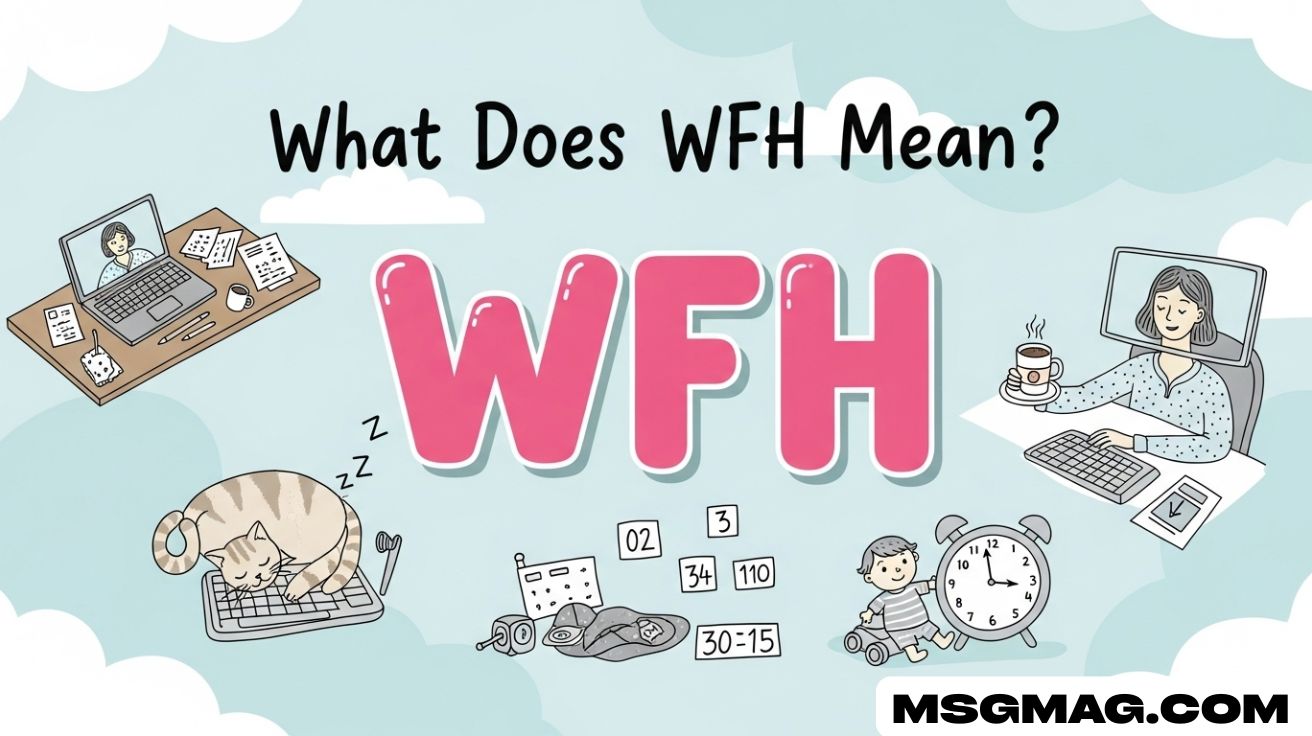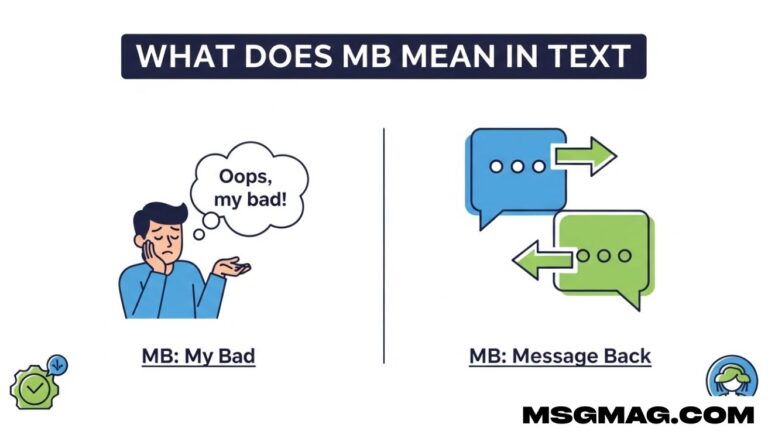What Does WFH Mean in Text? Quick Guide to the Acronym
WFH stands for Work From Home. It means doing your job from your own home instead of going to an office. Many people use it in texts, emails, and online messages.
You may have seen WFH in messages or on social media. It is a popular term today. Knowing what it means can help you understand conversations quickly.
WFH is part of remote work culture. People can join meetings, send emails, and finish tasks from home. It is flexible and helps with work-life balance.
Definitions & Meaning
WFH is an acronym for Work From Home. At its core, it refers to performing work duties from one’s home workspace, rather than commuting to a centralized office. The concept is closely linked to remote work, telecommuting, and telework, all of which emphasize the ability to work from locations outside the traditional office. In modern digital communication, WFH is often used as a shorthand in corporate emails, Slack messages, and other messaging platforms to quickly convey that someone is present and working, but not physically in the office. It is important to note that WFH does not mean a day off—it implies full engagement in professional responsibilities while utilizing the flexibility of a home or remote environment.
The term is also tied to broader trends like flexible scheduling and work-life balance, allowing employees to design their day around productivity from home while managing personal responsibilities. Over time, WFH has become a standard part of office communication, influencing policies, job descriptions, and even workplace culture.
Examples:
WFH appears in a variety of communication contexts. For example, a colleague might send a Slack message saying, “I’ll be WFH today, but reachable via email.” Similarly, a manager may add “WFH Tomorrow” to a calendar entry for team check-ins. In corporate emails, WFH can be included in subject lines, such as “WFH Today – Urgent Only,” signaling that the sender is available but working remotely.
On social media, WFH is often used humorously. Posts may read, “Day 100 of WFH: My cat is now my manager,” or “WFH vibes = working in pajamas until 3 PM.” These examples illustrate how the acronym blends professional reality with personal life, reflecting the work-from-home lifestyle that has emerged during the COVID-19 pandemic and pandemic lockdowns. Even casual text abbreviations such as WFH have become widely recognized symbols of modern office communication.
Origins & History
Although WFH became a household term during the COVID-19 pandemic, the concept of working remotely has existed for decades. In the early 2000s, as internet access improved and digital communication tools became more advanced, many companies experimented with home-based work and telecommuting. The specific acronym WFH began appearing in corporate emails and messaging platforms around the mid-2010s, primarily within industries like software development, customer support, and digital marketing. It was initially a convenient shorthand for remote collaboration and internal professional communication.
The global pandemic in 2020 dramatically accelerated WFH adoption. Millions of employees worldwide transitioned to home office setups virtually overnight, and WFH became part of online trends and everyday conversation. Over time, it has evolved from a temporary necessity to an integral component of hybrid schedules, flexible work, and distributed work models in the USA and beyond.
Usage in Different Contexts
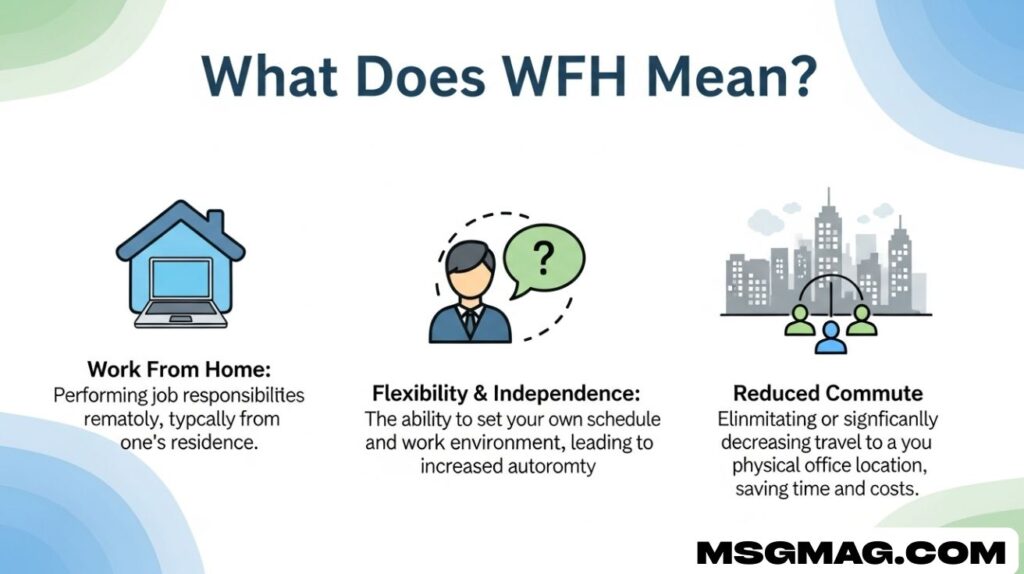
While WFH consistently means Work From Home, its application differs depending on the platform or context. How it is used in professional settings can differ significantly from social media or pop culture references.
1. Professional Settings
In professional communication, WFH is a practical way to signal availability while working remotely. Employees often use Slack messages to notify teammates: “I’ll be WFH today; please ping me if anything urgent comes up.” Out-of-office replies may read, “Currently WFH with limited access to desk phone.” Internal HR updates might announce: “The company will observe a WFH day due to weather conditions.” WFH in this context reflects job flexibility, productivity from home, and efficient remote team management. It is part of corporate emails, team check-ins, and professional communication norms in a modern home workspace.
2. Social Media
WFH has also entered social media posts, often in a lighthearted or humorous tone. Platforms like Twitter, Instagram, and TikTok are filled with memes about WFH. Users post about Zoom calls, working in pajamas, or managing home-based work distractions. This casual use emphasizes the work-from-home lifestyle, blending professional duties with personal life. It also reflects broader online trends that celebrate or critique remote work realities, often with humor.
3. Pop Culture
The acronym WFH has influenced pop culture. Comedy sketches and skits frequently reference chaotic home office scenarios, humorous remote collaboration fails, or awkward Zoom call moments. Even songs and satirical videos incorporate the WFH experience, highlighting the cultural shift in how people perceive productivity, job flexibility, and work-life balance. These references make WFH a shared term in both professional and personal contexts, contributing to modern workplace culture.
Common Misunderstandings & Clarifications
While WFH seems straightforward, there are several misconceptions about what it truly means. Addressing these misunderstandings ensures clarity in both professional and casual settings.
❌ Misconception 1: WFH Means You’re Not Working
Many people assume that WFH implies a day off, but in reality, it signifies full engagement in professional duties from a home office. Employees continue working remotely while utilizing the flexibility of their home environment.
❌ Misconception 2: WFH Is Less Productive
Some believe that productivity from home is lower than in an office. However, studies during pandemic lockdowns showed that many employees were equally or more productive while working remotely. Tools like messaging platforms, Slack messages, and Zoom calls have supported effective remote collaboration, making WFH a productive option.
❌ Misconception 3: WFH Is Permanent
WFH is not always permanent. For many, it is a temporary measure due to health concerns, travel, or special projects. Others work on a hybrid schedule, splitting time between a home workspace and the office. Flexible scheduling allows companies to tailor WFH policies to employee needs.
❌ Misconception 4: WFH Applies Only to Tech Jobs
While tech companies were early adopters, WFH now spans multiple industries, including finance, healthcare (telemedicine), education, customer service, and creative roles. Any job compatible with digital communication and remote team management can incorporate WFH.
Alternatives & Synonyms
WFH is just one way to describe working remotely, and several terms are closely related or interchangeable. Remote work is a broad term covering any location outside a central office, while telecommuting or telework often refers to structured home-based tasks. A hybrid work model combines in-office and home-based work, whereas distributed work emphasizes teams spread across multiple locations. Flexible work and job flexibility cover remote options as well as adjustable schedules. Finally, a home office refers to the actual home workspace used for professional duties.
| Term | Meaning |
| Remote Work | General term for working outside a central office |
| Telecommuting | Older corporate/government term for working from home |
| Hybrid Work Model | Combination of in-office and home-based work |
| Distributed Work | Teams working across multiple locations or time zones |
| Flexible Work | Adjusted schedules or remote options |
| Home Office | Physical workspace at home used for WFH |
Understanding these alternatives ensures proper usage in corporate emails, job postings, and daily office communication.
Understanding WFH in Today’s Digital World
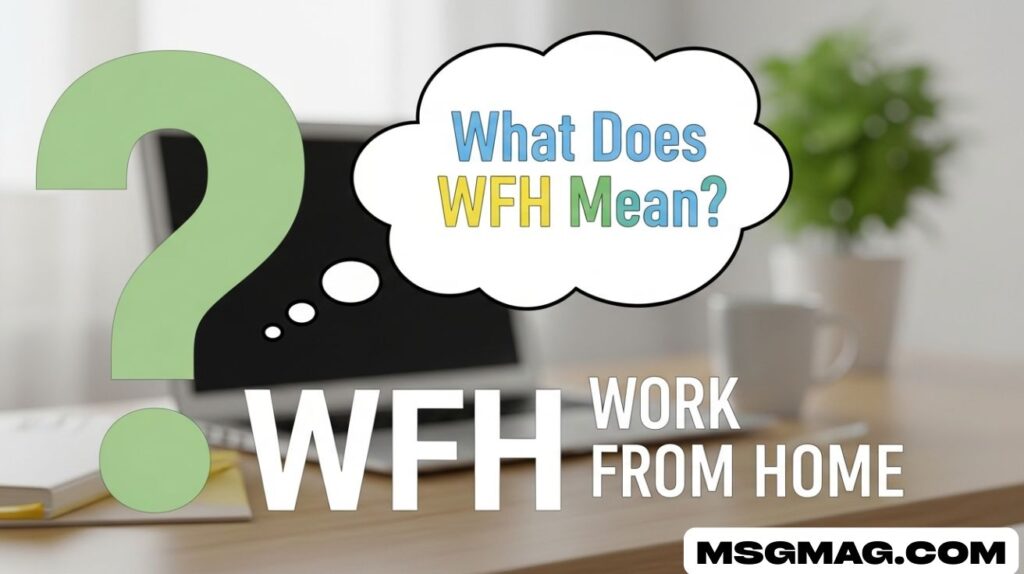
WFH, short for Work From Home, has become a common term in remote work culture. Whether in Slack messages, corporate emails, or text abbreviations, knowing what WFH means helps employees and teams communicate clearly. It also reflects the shift toward flexible work and home-based work, making professional communication more efficient.
The rise of WFH connects closely to the COVID-19 pandemic and pandemic lockdowns, which forced millions to adapt to digital communication. Modern employees now manage home office setups, team check-ins, and remote collaboration, balancing productivity with personal life. Understanding WFH is essential for navigating both professional and casual communication effectively.
Read Also : What Does FYA Mean in Text?
The Origins of WFH
The term WFH first appeared in corporate emails and messaging platforms in the mid-2010s, mainly in tech and digital marketing industries. Early adopters found it a convenient shorthand for telecommuting and remote work, helping colleagues coordinate without confusion. Over time, it spread to multiple sectors as home-based work became practical.
WFH gained mainstream attention during the COVID-19 pandemic, when millions of remote employees were forced to work from home. It evolved from an internal corporate term to a global work-from-home lifestyle phenomenon. Today, WFH reflects broader trends in flexible scheduling, hybrid work models, and distributed work, redefining how work-life balance is approached.
How WFH Impacts Productivity
Contrary to popular belief, WFH does not reduce productivity. Many employees find working remotely increases efficiency due to fewer office distractions and flexible schedules. Tools like Zoom calls, messaging platforms, and digital communication help maintain productivity while managing tasks in a home workspace.
Research shows companies adopting WFH models report higher employee satisfaction and engagement. Remote work, telecommuting, and home-based work provide autonomy while supporting collaboration. The ability to balance professional duties with personal life through WFH improves both work-life balance and overall remote employee performance.
Common Misconceptions About WFH
One common misconception is that WFH means employees are not working. In reality, WFH indicates full engagement from a home office. Another misconception is that WFH is only for tech jobs, whereas it now applies to finance, healthcare, education, and creative roles.
Many also assume WFH reduces productivity, but evidence shows that telework can maintain or even improve output. WFH is sometimes considered permanent, yet most companies adopt hybrid models. Understanding these misconceptions helps organizations and individuals navigate flexible work, remote collaboration, and modern office communication more effectively.
WFH in Social Media and Pop Culture
WFH has also influenced social media posts and popular culture. Users share humorous posts about Zoom calls, working in pajamas, and managing pets while working remotely. Memes about WFH highlight the home-based work experience, making it relatable to millions.
Pop culture references often depict chaotic home office setups or virtual meetings gone wrong. By appearing in videos, songs, and skits, WFH reflects the evolving work-from-home lifestyle. It also reinforces trends in remote team management, digital communication, and flexible scheduling, making WFH both a professional and cultural phenomenon.
WFH and Hybrid Work Models
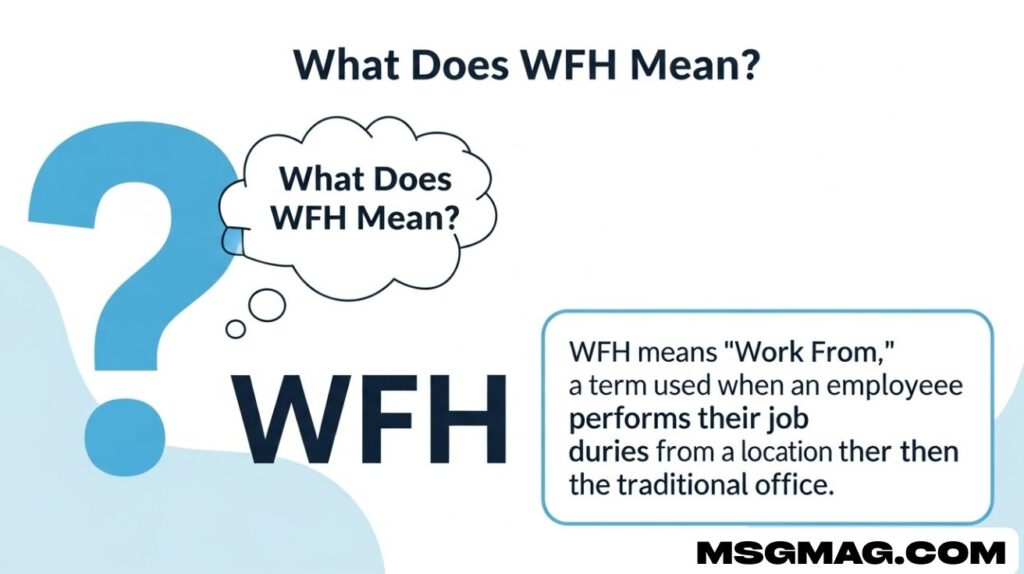
Many organizations now combine WFH with office presence through hybrid schedules. Employees work part of the week in a home workspace and part in the office. This hybrid work model allows remote employees to balance productivity, collaboration, and personal flexibility effectively.
Hybrid models support distributed work and remote collaboration, giving companies flexibility while maintaining professional standards. Employees benefit from autonomy, reduced commuting, and job flexibility. WFH in combination with hybrid models ensures companies can adapt to changing work trends while maintaining professional communication and team check-ins efficiently.
Preparing for a Successful WFH Experience
To succeed in WFH, setting up a proper home office is critical. A designated workspace, reliable internet, and organized digital communication tools ensure productivity from home. Employees should maintain professional communication standards through Slack messages, emails, and Zoom calls.
Establishing routines and flexible scheduling improves focus and reduces burnout. Regular team check-ins, clear deadlines, and collaboration strategies help remote teams stay connected. Understanding WFH expectations, combined with proper tools and work-from-home lifestyle habits, ensures both individual and team success in modern remote work environments.
FAQs
What does WFH stand for?
WFH stands for Work From Home, meaning performing job duties remotely from your home.
What does WFH mean on Snapchat?
On Snapchat, WFH is used casually to indicate someone is working from home while staying connected online.
What does WFH mean on TikTok?
On TikTok, WFH often appears in videos or captions to show the home-based work lifestyle humorously or creatively.
What is WFH in social media?
In social media, WFH refers to working remotely and is commonly shared in posts, memes, or stories about home-based work experiences.
Conclusion
WFH—Work From Home—is more than an acronym; it is a reflection of how remote work, hybrid schedules, and flexible work practices have transformed professional life. From Slack messages and corporate emails to social media posts and memes, WFH has become part of both professional and cultural language. By understanding its meaning, usage, and alternatives, employees and managers can communicate clearly and adapt to the evolving work-from-home lifestyle.
Whether you are a remote employee, managing team check-ins, or participating in remote collaboration, knowing WFH ensures you stay connected, productive, and flexible in today’s modern workplace.

